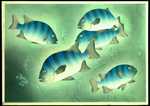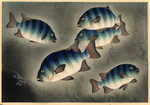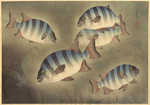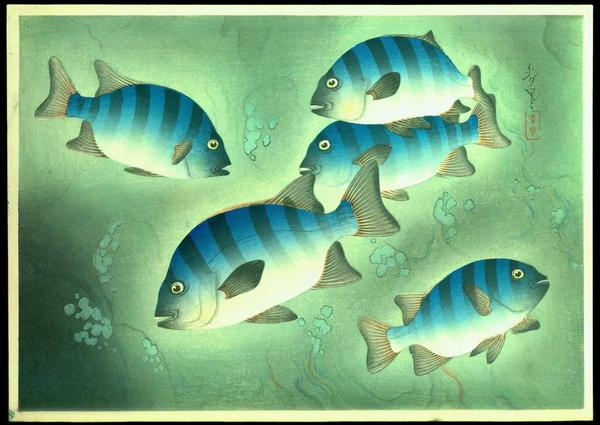| | |
| Artist: | Bakufu Ohno (1888-1976) — 大野麦風 |
| Title: | Parrot Fish (Ishidai) — イシダイ |
| Series: | Familiar Fishes of Nippon — 大日本魚類画集 |
| Date of first edition?: | 1939/2 |
| Date of this artwork?: | 1946-50 (may not be accurate) |
| Publisher (first edition)?: | Nishinomiya Shoin — 西宮書院 |
| Publisher (this edition)?: | Kyoto Hanga-In — 京都版画院 |
| Medium (first edition): | Woodblock |
| Medium (this edition): | Woodblock |
| Format (first edition): | Oban
|
| Format (this edition): | Large Oban |
| DB artwork code: | 41485 |
| Notes (first edition)?: |
From Volume 2, print number 6.
作家: 大野麦風 Ono Bakufu
作品: 大日本魚類画集 イシダイ
Great Japanese Fish Picture Collection / The Ishidai (Rock Sea Bream)
技法: 木版
サイン: 直筆サイン
状態: 良好
サイズ: 27×39cm(イメージサイズ)
制作年" 昭和14年(1939)
付帯品: 解説書
備考・解説" 西宮書院版
Oplegnathus fasciatus, the barred knifejaw or striped beakfish, is a species of knifejaw native to the northwestern Pacific Ocean though there area a smattering of records from other localities in the eastern Pacific such as Hawaii and Chile. It is an inhabitant of rocky reefs and occurs at depths of from 1 to 10 metres (3.3 to 32.8 ft). Juvenile members of this species can be found with patches of drifting seaweed. This species can reach a length of 80 centimetres (31 in) TL with the greatest recorded weight for this species of 6.4 kilograms (14 lb). The color pattern consists of light and dark vertical bars from which it derives its name. It has been recorded as feeding on hard-shelled invertebrates such as crustaceans and molluscs. It is a commercially important species and is also farmed. It is also sought after as a game fish.[1] A striped beakfish is the surviving specimen of five striped beakfish that endured more than two years in the partially submerged hull of the Japanese boat Sai-shou-maru.[2][3] |
|
| Notes (this edition)?: |
| The following information was taken from the original web listing of this artwork. Note that there may be some inaccuracies:
Monday, 14 July 2008
Peter Belsito
This is probably a later edition circa 1946-50 using recarved blocks. |
|
| Artist Bio: |
Bakufu Ohno (1888-1976) was born in Tokyo. He moved to Kansai after the great Kantou earthquake in 1923. Ohno exhibited oil paintings at Teiten in 1929. He was an honorary member of the Hyogo Prefecture Academy of Fine Arts, and a member of Taiheiyogakai. Ohno produced many landscape and fish prints, including the Great Japanese Fish Picture Collection (Dai Nihon gyorui gashu) in 1940, which was published by Kyoto Hanga-in; blocks were carved by Matsuda and Kikuda, printed by Shinagawa, Nagae, Uchida and Ohno.
大野麥風(1888-1976、本名:要蔵)は、東京で生まれ、初めは長原孝太郎の指導を受け、洋画を学びました。1909年の第3回文部省美術展覧会で画壇に登場してからは、白馬会・太平洋画会・光風会などにも出品したものの、やがて、洋画から日本画に転向し、1919年の第1回帝国美術院展覧会では、日本画で入選しています。
さらに、木版画を手がけるようになった麥風は、1937年に西宮書院(現在の京都版画院)から出版された代表作 『大日本魚類画集』で、原画を担当し、当代一流の文化人の協力を得て、「原色木版二百度手摺り」といわれる色鮮やかな木版画集を生み出しました。会員制度で頒布されたこの500部限定の木版画集は、1944年まで各回12点、6期に分けて断続的に刊行され、麥風は水族館では飽き足らず、和歌浦沖で潜水艇に乗り、魚の生態を観察し、細部にまでこだわった作品を作り上げました。 |
|






